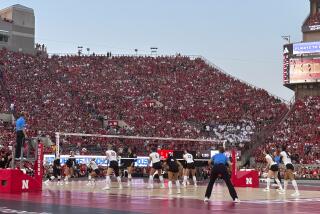Nielsen’s Stadium Receives Very High Ratings
- Share via
MADISON, Wis. — Hundreds of students trudge through deep snow while others cross-country ski with tennis balls and rackets tucked under their arms on miserable winter days in this northern capital.
Bundled in heavy fur coats, wearing ear muffs, wool-head coverings, gloves, boots, they head for the huge red brick Nielsen Tennis Stadium at the University of Wisconsin--Madison campus.
They arrive as early as 6 a.m., stay as late as midnight.
Subzero temperatures, drifting snow and gloomy overcast skies here often linger days on end.
Yet, the University of Wisconsin boasts one of the most active tennis programs of any school in America, thanks to the late Arthur C. Nielsen of television rating fame.
Nielsen and his wife Gertrude, both Wisconsin grads, donated $2,156,000 to build the mammoth stadium with a dozen indoor tennis courts and six indoor squash courts “in grateful appreciation of the privilege of good education.”
At the time of the Nielsen Tennis Stadium dedication in 1968, it was the largest indoor tennis facility ever constructed and the biggest building of the 200 structures on the Madison campus.
Taking tennis as a PE course is extremely popular here. Student workshops and group lessons take place on half the courts several hours every day.
Emphasis is on student use. Faculty and staff come next. Public use is last and accounts for only 6% of court play.
“With this kind of facility, the best anywhere, one would think our men’s and women’s teams would win the Big Ten championships year in and year out,” said Pat Klingelhoets, 35, men’s tennis coach the past four years.
Yet Wisconsin has never won a Big Ten tennis championship.
“We’re improving and should win one of these years. It certainly isn’t for lack of an adequate place to play. Every year we have great expectations,” Klingelhoets said.
Arthur C. Nielsen graduated from Wisconsin in 1918, his wife in 1920. Nielsen’s parents were immigrants. He worked his way through school with the help of scholarships.
He founded the A.C. Nielsen Co. in 1923, a firm that became one of the nation’s leading marketing information and business information corporations. Nielsen died in 1980.
“Dad loved tennis and squash. He played both sports until shortly before he died. He developed cataracts, couldn’t see the ball anymore and reluctantly had to quit,” recalled his son Arthur A. Nielsen Jr., 66, retired chairman of the A. C. Nielsen Co.
Nielsen tells how his father would use the armory at Wisconsin on winter weekends to play tennis. “He would put the lines down himself, painting them on the dirt floor in the armory, then put up the net.
“The lighting wasn’t very good and the bounces on the dirt court were lousy. Dad felt he could have been a much better tennis player if he had a decent place to play in winter.”
Conditions hadn’t improved much by the time A. C. Nielsen, Jr., attended Wisconsin. “When I went there,” he said, “we put canvass on the basketball court to make a tennis court. It was a big job. The maintenance people didn’t like to do it. We got to play only once or twice a week.”
He was captain of Wisconsin’s tennis team in 1940 and 1941. A. C. Nielsen Sr. and Jr. won the National Father and Son Tennis Championship in 1946 and 1948 and were the runners-up in 1939, 1945 and 1947.
The day of dedication of the Nielsen Tennis Stadium father, son and a grandson, A. C. Nielsen III, played on one of the indoor courts.
“My father always said tennis was a sport for a lifetime. He said it kept a person healthy and was much better than hanging around saloons,” said A. C. Nielsen Jr. “He felt that the one thing that helped him most in life and in his career was getting an excellent education. He felt very good about building the tennis stadium for his alma mater.”
There were no corners cut in building the stadium. The court surfaces here are the most expensive in existence, a resilient type of surface with a little bit of give, topped with one quarter inch rubberized asphalt. The surface softness minimizes fatigue, yet provides a perfect bounce with every ball hit.
There’s more spectator space than in any existing indoor court. Viewers have the ability of watching play on eight courts simultaneously. Last year, 106,293 players used the stadium courts.
Play commences at 6 a.m. and ends at midnight. There are no memberships. Play is by reservation. Students pay $1.50 singles, 75 doubles for every one hour 15 minutes of play. Faculty and staff pay $3.35 singles, $1.65 doubles and the public $7.00 singles, $3.50 doubles.
Frances McPherson, one time woman’s champion of Nebraska, has been stadium director the past seven years. She received her Ph.D. from Wisconsin in 1965 in physical education.
“The courts are full nearly all the time. A lot of students play late at night. They can’t get a reservation earlier. Some people prefer to play at 10 or 11 o’clock at night. They’re night people. Others like to play first thing in the morning,” she said.
Intercollegiate play is a big thing at the stadium, where spectators seating capacity is 1,500. As many as 1,000 more watch the matches standing.
Every year the Wisconsin High School State tennis championships are held at the Nielsen Tennis Stadium.
“It’s a great place to play, especially this time of the year,” said Bill Sparks, 18, a freshman from Marshfield, Wis. “The temperature is the same year round in the stadium.”
More to Read
Go beyond the scoreboard
Get the latest on L.A.'s teams in the daily Sports Report newsletter.
You may occasionally receive promotional content from the Los Angeles Times.










